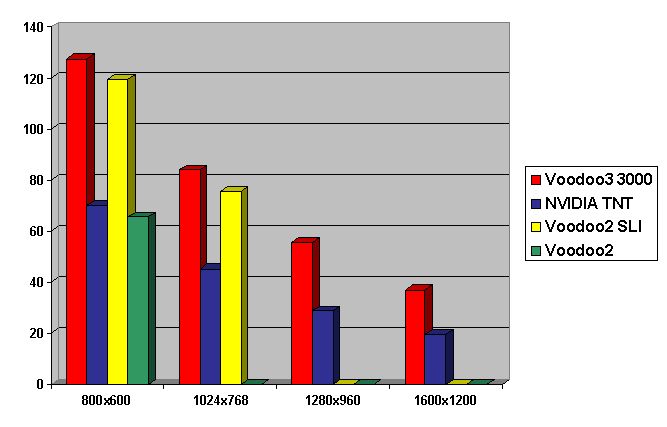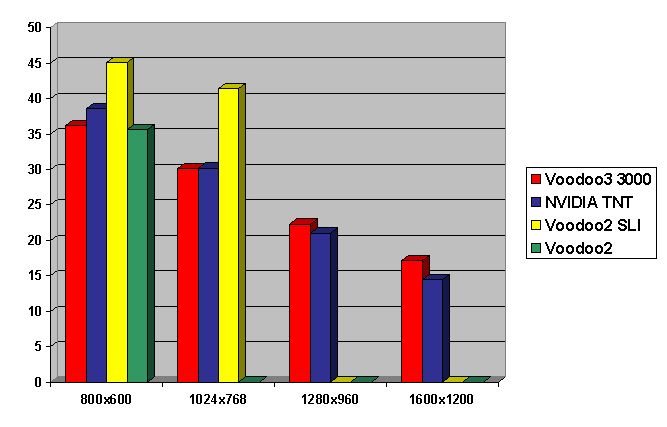 |
|
|
|
In the Forums... |
Posted: March 28, 1999 Written by: Dan "Tweak Monkey" Kennedy Estimated retail price: $179.99 Performance Test System
ABit BX6 mainboard 64 MB PC100 SDRAM Voodoo3 3000, Canopus Spectra 2500 (NVIDIA TNT) Drivers: Voodoo3 - included pre-release drivers (3-20-99); NVIDIA TNT - Latest drivers available as of 3-28-1999. 19" Optiquest V95 monitor VSYNC DISABLED with all cards Diamond Monster Sound MX200 Windows 98 Operating System Turok 2 T2Mark test (turok2.exe -benchmark)  Additional settings: Detail set to "High", Trilinear filtering enabled. Turok 2, a Direct3D based first person shooter, serves as a great benchmark because of the fast paced action and impressive graphics. The results from the 800x600 test show that the Voodoo2 SLI still holds the crown (at least for now) as the Direct3D king. The NVIDIA TNT based Canopus Spectra 2500 is running a little bit faster than a single Voodoo2, but trailing far behind the Voodoo3 3000 and the Voodoo2 SLI. When the resolution is bumped to 1024x768, the Voodoo2 SLI takes a fairly large performance hit... more so than the Voodoo3 3000. The slight performance hit barely takes a toll on the Voodoo3 3000, which recovers from the second place position and surpasses the older Voodoo2 SLI. The NVIDIA TNT takes a major performance hit and drops far behind. The Voodoo2 was not included because as mentioned above, it does not officially support this resolution. The 1280x960 test severely hurts the NVIDIA TNT's performance. Over a 30% hit in performance occurred. The Voodoo3 suffered only a 17% hit, which ensured an even further lead over the already sub-30 FPS TNT. At this point, the TNT was already running fairly choppy, and gameplay was hindered. The Voodoo3 was still running as smooth as butter. At 1600x1200, things change a bit. Both cards take a 29% performance hit, but this puts the TNT far beyond the poor performance barrier, while the Voodoo3 is still running Turok2 with very little slow-down or choppy play. The visual quality for all cards was very similar. The TNT's "superior image quality" did not show through at all. Overall, Direct3D support for the Voodoo3 is excellent, and the performance is very impressive. GLQuake Timedemo 2 (timedemo demo2)  Additional settings: Joystick disabled, 16 bit color for all platforms. GLQuake is one of my favorite benchmarks because it always shows a variety in performance and visual quality. Also, it is not very CPU dependent, so the results are based primarily on video speed. The 800x600 results differ greatly from those in Turok2. The Voodoo3 3000 screams along at over 127 FPS, kicking the Voodoo2 SLI configuration back a notch. The NVIDIA TNT beats the Voodoo2 by a fair margin, but is outputting about half the framerate of the Voodoo3 3000 and the Voodoo2 SLI. The visual quality in this test in definitely given to the TNT which shows very little signs of a low resolution and a less grainy display than the 3Dfx cards. At 1024x768, the Voodoo3 is still significantly faster than the Voodoo2 SLI. All cards have dropped in performance by a large margin. The NVIDIA TNT, however, still trails far behind the competition. At this point, the gameplay is still solid, quick, and smooth on all cards. The visual difference is now less apparent, as the higher resolution results in less grainy output. The NVIDIA TNT takes a near 1/2 performance drop at 1280x960. The game is now slightly choppy and a tiny bit slow. The Voodoo3 takes a performance hit from 1024x768 to 1280x960 of about 34%, but it still remains in the mid 50s, so the gameplay is smooth and consistent. The visual difference is almost non-existent now. Another 30% performance drop occurs when the TNT's resolution is bumped to 1600x1200. The gameplay is now very choppy and slow. The Voodoo3 drops about 33% from this resolution change, but it still remains in the upper 30s and remains smooth. The visual difference is now negligible. The only major visual difference is the brightness. The TNT offers a much darker, somewhat richer output. The Voodoo3 is bright (and may therefore appear "washed out") but can be adjusted to look the same with simple tweaking. Quake II Timedemo 1 (map demo1.dm2)  Additional settings: Joystick disabled, 16 bit textures, high quality sound, 16 bit color for all platforms. Quake II's least intensive benchmark, demo1, is perfect for a comparison of what single player gameplay is like at various resolutions. The action is not intense, but it offers a great variation in performance because of this. When the game is tested at 800x600, the performance difference is very similar to GLQuake. The Voodoo2 SLI is ahead of the Voodoo3 3000, while the Voodoo2 is slightly behind the NVIDIA TNT. Again, both the TNT and the single Voodoo2 are far behind the Voodoo2 SLI and the Voodoo3 3000. The visual difference is noticeable, but not major. A slightly higher resolution of 1024x768 sets the Voodoo2 SLI 7 FPS behind the Voodoo3 3000. The NVIDIA TNT takes a major dip and is now running at less than half the speed of the Voodoo3 3000. At 1280x960, the two cards take a major performance hit again. This puts the TNT down into the mid 20s, which results in choppy output. The Voodoo3 is still doing fine at about 50 FPS, and is therefore running fine. Once the resolution is set as high as 1600x1200, even the Voodoo3 3000 shows signs of slightly choppy gameplay. The larger explosions and rooms lead to somewhat slower action. At this point, the NVIDIA TNT is far behind the line of crisp gameplay and is now barely making it through a timedemo. The visual difference is still the same, and can be altered for the most part by simple brightness tweaking of variables like gl_modulate, intensity, and vid_gamma. Quake II Crusher demo (map crusher.dm2)  Additional settings: Joystick disabled, 16 bit textures, high quality sound, 16 bit color for all platforms. The Crusher demo, designed by Brett "3 Fingers" Jacobs, is probably the most intensive Quake II benchmark available. The demo simulates a massive multiplayer match, and the action is constant. The 800x600 results show a very different outcome than other tests. The Voodoo2 SLI easily takes the #1 spot, and the others are significantly lower. The Voodoo3 3000 barely scores higher than a Voodoo2, and is about 3 FPS lower than the NVIDIA TNT. At 1024x768, the Voodoo3 gains on the TNT, but still remains far behind the Voodoo2 SLI. None of the cards take a large performance hit from the higher resolution. Now, at 1280x960, the Voodoo3 passes the TNT. Both cards are very choppy by now and such intensive gameplay is very slow. At 1600x1200, the Voodoo3 has extended the lead over the TNT, but both cards remain very choppy. The Voodoo2 Crusher demo results were increased a lot during driver optimizations, so I assume that this 3Dfx pattern will continue and the Crusher framerate will increase with the Voodoo3 as new drivers are released. Overall Performance  Note: This is an average of the previous tests. Voodoo2 and Voodoo2 SLI results were excluded because they did not include all resolutions. The pattern remains the same when all scores are averaged together. The Voodoo3 is significantly faster than the TNT, and even the 1600x1200 average framerate (30.3) is enough to ensure near flawless gameplay with most of the latest action filled games. The Voodoo3 3000's performance is far beyond what I expected or even imagined. I am certainly not going to complain about 30+ FPS 1600x1200 results. I am not sure how the TNT-2 will compare, but it will be a definite challenge for NVIDIA to achieve such high numbers. |
||
|
| |||
|---|---|---|---|